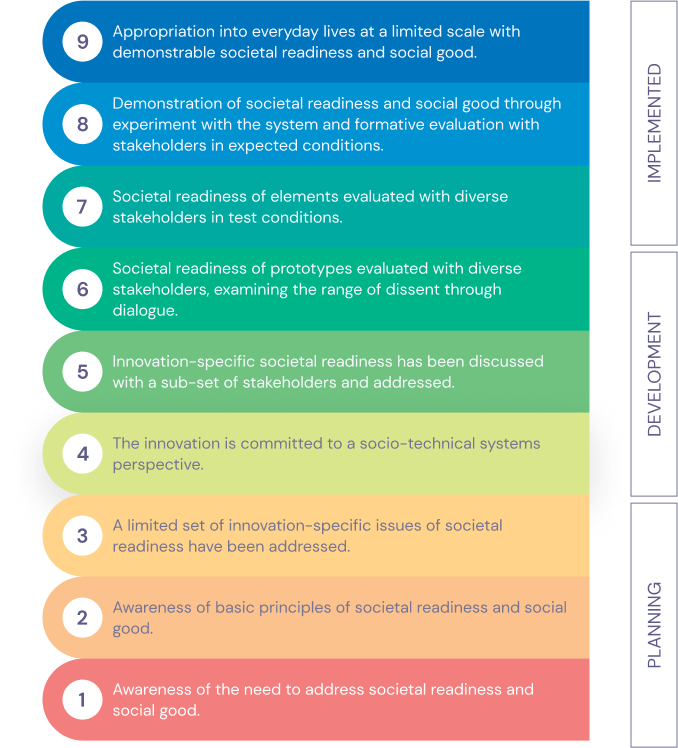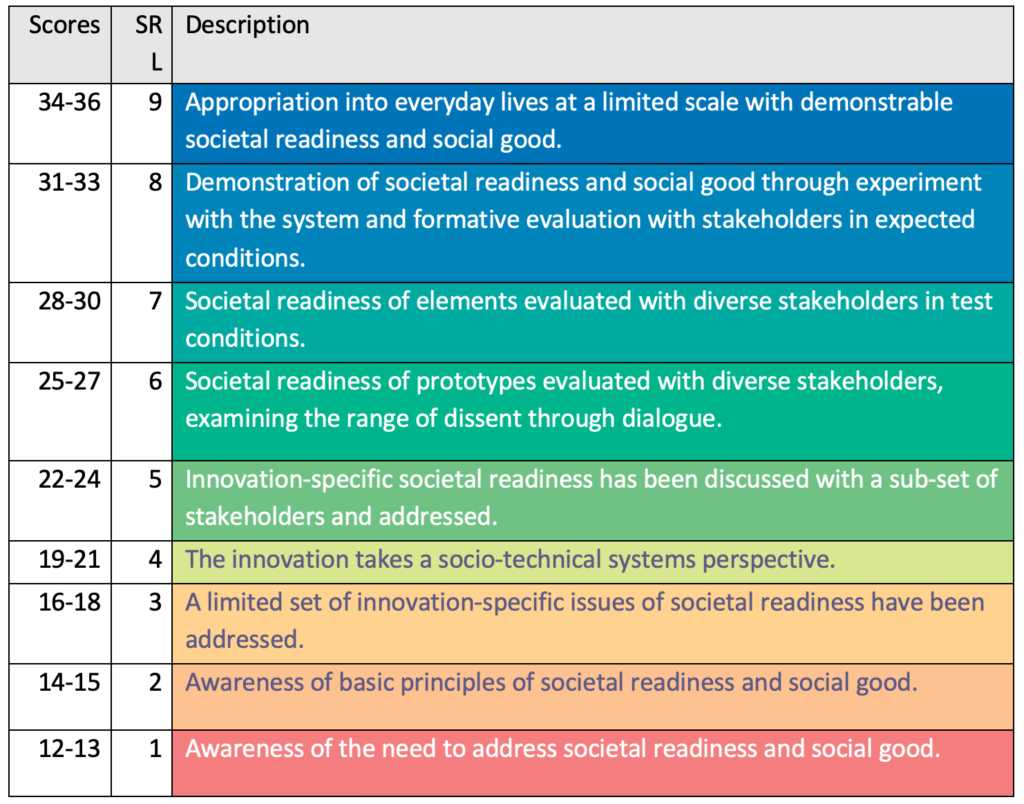How SRL are calculated
Societal readiness is a complex challenge. SoRA is a tool for reflection, dialogue and creative improvement, NOT a measure of an objective level of societal readiness. It is not a tickbox exercise. We advise that you spend your energy on considering the questions and your reasoning, and seeking dialogue with others.
In this spirit, we measure Societal Readiness Levels by treating your answers as indicators of Awareness, Ambition, and Deliverability in relation to key aspects of Carbon Reduction, Social Justice, Social Impact, and Fit for a Decarbonised Society. The system scores your answers to the 12 Reflective Questions and matches your overall score to a grading scheme.

What SRL to expect?
The fact that you are considering the need for societal readiness is a big step. How well you are doing in terms of SRL can vary in relation to your own ambitions, your awareness of the scale and complexity of the challenge, the stage your project is in (Planning, In Progress, or Implemented). SRL are not an objective measure and the main aim is to improve. So if you score lower (or higher) than you expected, use the SoRA tools to explore why and improve the societal readiness of the project. If you score higher than expected – use the SoRA tools to check your ambitions and interpretative frame – are you aiming too low?
Why not cheat?
You will notice that it is not difficult to ‘cheat’ and produce high SRL scores by working out how SoRA is scored. But you’d be cheating yourself. By scoring a project honestly and critically, and in a reflective approach, you can discover opportunities for improvement. By inviting others to score the same project, you can find opportunities to collaborate. If people have different views about the societal readiness of a project, discuss their reasoning with them. If you encounter dissent, that is a really good thing! You are getting to a place where you can understand better why societal readiness fails and how you can make it flourish. Using the SoRA Toolbox will help you improve the project’s societal readiness.
The scores indicate (3) high, (2) medium, or (1) low levels of Awareness, Ambition and Deliverability in relation to each question as follows:
| Carbon Reduction | ||
| 1.1 To what extent is decarbonisation a key priority for the project compared to other priorities? | ||
| Awareness | High (e.g. it is explicitly targeting carbon reduction) | 3 |
| Medium (e.g. carbon reduction is balanced against other priorities) | 2 | |
| Low/I can’t tell (e.g. decarbonisation is not a major concern) | 1 | |
| 1.2 How informed is the design about carbon budgets? For example, the 2021 UN Climate Pathway for Transport suggests that passenger and freight transport should be completely decarbonised by 2050, and many national and local plans reflect this. | ||
| Ambition | High (e.g. there is clear and transparent reference to carbon budgets) | 3 |
| Medium (e.g. the design is either well informed or the design team recognise the need to bring in expertise) | 2 | |
| Low/I can’t tell (e.g. the decarbonising objectives are vague) | 1 | |
| 1.3 Compared to the target for complete decarbonisation of passenger and freight transport by 2050, what is this projects contribution to actual reduction of carbon emissions? | ||
| Deliverability | 1.3-1 High (e.g. Carbon reduction would be very significant) | 3 |
| 1.3-2 Medium (e.g. Carbon reduction is good but does not fully recognise the scale and urgency of the challenge) | 2 | |
| 1.3-3 Low/I can’t tell (e.g. The degree of actual carbon reduction is low or unclear) | 1 | |
| Social Justice | ||
| 2.1 To what extent are the stakeholders who might be affected (positively or negatively) considered? | ||
| Awareness | High (e.g. There are defined processes to identify a wide range of stakeholders) | 3 |
| Medium (e.g. The importance of working with stakeholders is recognised, but capacity to include all is limited) | 2 | |
| Low/I can’t tell (e.g. A small selection of key stakeholders is considered) | 1 | |
| 2.2 What level of active engagement with stakeholders has there been at this point? | ||
| Ambition | High (e.g. There is a co-design process and a degree of stakeholder ownership of the design) | 3 |
| Medium (e.g. Stakeholder consultation is an integral part of the design) | 2 | |
| Low/I can’t tell (e.g. Stakeholders are not considered explicitly) | 1 | |
| 2.3 To what extent does the design concretely address the needs of all stakeholders? | ||
| Deliverability | High (e.g. The needs of diverse stakeholders are addressed in transparent and accountable ways) | 3 |
| Medium (e.g. There is clear but limited effort to address the needs of marginalised stakeholders) | 2 | |
| Low/I can’t tell (e.g. It is assumed that the needs of stakeholders can be addressed in the implementation or through regulation) | 1 | |
| Social Impact | ||
| 3.1 Projects inevitably have unexpected societal ripple effects. Decarbonising transport can bring co-benefits such as clean air and well-being, but also negative consequences. For example, increased home-working can intensify worker surveillance. To what degree are co-benefits, unanticipated consequences, ethical or wider societal implications considered? | ||
| Awareness | High (e.g. There are clear processes to reveal and consider a wide range of wider consequences) | 3 |
| Medium (e.g. The project considers some, but not all of these aspects) | 2 | |
| Low/I can’t tell (e.g. There is little attention to potential co-benefits or harms) | 1 | |
| 3.2 How actively are potential societal co-benefits or harms explored? | ||
| Ambition | High (e.g. Experiments with stakeholders are designed to reveal surprises and enable dialogue) | 3 |
| Medium (e.g. Wider effects of the project are explored to some extent, but there is no structured methodology) | 2 | |
| Low/I can’t tell (e.g. There is no effort to explore co-benefits or harms, or it is limited) | 1 | |
| 3.3 To what extent was the project adapted to maximise benefits or minimise harms? | ||
| Deliverability | High (e.g. There are defined processes for addressing benefits and harms) | 3 |
| Medium (e.g. There have been some adaptations in response to user feedback) | 2 | |
| Low/I can’t tell (e.g. Maximising benefits and minimising harm are seen as users responsibility) | 1 | |
| Fit for a Decarbonised Future | ||
| 4.1 How does this project fit with social practices of low carbon lifestyles? | ||
| Awareness | High (e.g. The project understands, encourages and enables systematic societal changes in mobility) | 3 |
| Medium (e.g. There is an expectation that individuals change behaviour and limited support for such charge) | 2 | |
| Low/I can’t tell (e.g. The project relies on policy, individuals and society to make sustainable transport choices) | 1 | |
| 4.2 How does the project align with relevant government policies? | ||
| Ambition | High (e.g. The project challenges policy-makers to make more ambitious sustainable mobility policies) | 3 |
| Medium (e.g. The project meets or goes slightly beyond existing government policies) | 2 | |
| Low/I can’t tell (e.g. There is good fit with the main relevant policies) | 1 | |
| 4.3 How desirable and easy is it for businesses and transport operators to implement the project? | ||
| Deliverability | High (e.g. Businesses and transport operators have co-designed the project) | 3 |
| Medium (e.g. There is clear alignment with the most ambitious transport operators’ and business policies) | 2 | |
| Low/I can’t tell (e.g. There is good fit with current sustainability policies) | 1 |
The highest score possible is 36, the lowest 12. SRL are determined based on your score and specifically with a view to scores related to deliverability. If you score below 3 on the threshold ‘deliverability’ indicator questions (Q1.3, Q2.3, Q3.3, Q4.3) you cannot achieve an SRL higher than 4. This is because deliverability is a really important measure of societal readiness. If the project has high ambitions, but cannot deliver on them, serious work on social justice and social impact is likely to be required.
